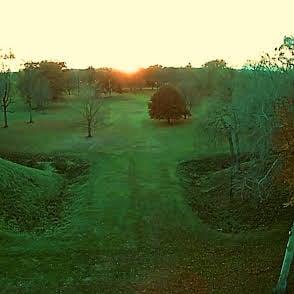Even the experts get it wrong once in a while.
Erected in 1929, on a ridge over a Maumee River floodplain south of Toledo, is an impressive statue commemorating the Battle of Fallen Timbers. It was the height of summer 1794, and a Native American confederacy made what would amount to one of several last stands against the invaders. The battle’s name was inspired by a tornado that had previously torn through the mix of prairie and forest. On the battlefield was future President William Henry Harrison, as was Tecumseh.
Near the statue is a notable rock moved here to honor the battle’s Native casualties. The legend goes a chief rallied his warriors from this rock – his last words before being gunned down. There’s decaying tobacco stuffed into chiseled holes, testimony First Nations continue to make offerings.
There’s one egregious problem with the statue, which is pictured above. It is honoring nothing more than wildflowers on a floodplain. Across a nearby freeway sits the actual battlefield, discovered in 1995 by an anthropologist. The error must have been made by the Ohio Historical Society, renamed the Ohio History Connection, and taxpayers paid for the correction. A pedestrian bridge now connects to the Toledo metro park which was set up to honor the true site.
When the Hopewell earthworks, such as the Octagon and the Great Circle in Newark (Ohio), were awarded World Heritage status in 2022, Ohio’s 15,000-year Native history was amplified across the globe. But Ohio’s ancient history is still very much a mystery, something the experts admit. Ohio Native tribes such as the Shawnee left no written word, and so this history became beset by speculation and sensationalism.
For instance, internationally acclaimed author and journalist Graham Hancock has surmised that Serpent Mound and its archeoastronomical connections are 15,000 years old, and not several thousand years old as the experts believe. Hancock’s Netflix series has become a global sensation as he claims the Natives who created Serpent Mound may have been influenced by a forgotten culture which traversed the planet following a cataclysmic flood so to restart civilization. Purists consider Hancock’s interpretations pseudoarcheology and racist, even though his wife, Santha, is an indigenous black woman from Malaysia.
Hancock’s claims are widely popular, perhaps due to his regular appearances on the Joe Rogan Experience podcast. The Free Press has witnessed Joe Rogan fans (young men) seek out Ohio History Connection employees at Serpent Mound during dusk on the summer solstice wanting to know more. But any publicity does not equate to good publicity for the Ohio History Connection which banned Hancock from filming at Serpent Mound in 2022. Coincidentally, in Hancock’s second Netflix series released in 2024, there was barely a mention of the Ohio earthworks, such as Serpent Mound, the Octagon or the Great Circle.
What can’t be denied is the attention Hancock and Rogan and have brought to Ohio’s earthworks like the Octagon, for which the Ohio History Connection fought tooth-and-nail. Eventually prying it away from the privileged white settler descendants who had turned this lunar temple into a playground.
Those who question the official historical record are often bullied and slandered, but the paradox is, they inspire countless others to learn more. And in rare cases the official historical record is quietly amended, as was the Battle of Fallen Timbers.
Homo Giganticus and the ‘salamander effigy mound’?
The levels of sensationalizing Ohio’s ancient history are, well, off the maps.
Dr. Edward Barnhart of “ArcheoED” podcast fame scoffs at Hancock’s sensationalism, but he himself has offered insights into the Hopewell and Adena which the Ohio History Connection would reject. He rightfully describes the Hopewell as the “first math nerds” of the Americas. But adds their conical mounds should be recognized as “pyramids.”
Downtown Columbus once had a pyramid then, hence “Mound Street.” It was forty feet tall, 300-feet around and partly made of clay. In Miamisburg (Ohio) a “pyramid” nearly twice that size still stands and was found to have burials and small chambers.
Then there’s Fritz Zimmerman, an unaffiliated scholar and author, who’s spent years researching Ohio’s “ancient ruins” (his description). Zimmerman has appeared on the paranormal radio show Coast to Coast, and his “The Nephilim Chronicles: Fallen Angels in the Ohio Valley” promotes a theory that has been discredited, but still has (long) legs: That a race of giants once inhabited Ohio.
“I advocate that the giants, with their protruding brown ridges and sloped skulls, were not modern Homo sapiens but represent a unique subspecies I call Homo giganticus. North America also had Homo floresiensis, also known as ‘hobbit people’,” Zimmeran told the Free Press.
The Ohio History Connection says Zimmerman’s research is terribly insulting toward Native Americans. But his research has uncovered intriguing celestial alignments that few are aware of at the Great Circle. The Great Circle is a short distance from the Octagon, and together are the masterpieces of the Hopewell Ceremonial Earthworks World Heritage sites as appointed by the Paris-based United Nations Educational, Scientific and Cultural Organization or UNESCO.
At dawn on May 1st of this year, and past years on this day, a small group stood in the middle of the Great Circle on top of its ‘bird effigy’ earthwork awaiting the rising sun. They were looking straight ahead out the Great Circle’s corridor entrance. And, just as the Serpent Mound’s head does at dusk on the summer solstice, the sun and the Great Circle aligned. On October 31st at the Great Circle, the sunset aligns in the opposite direction (pictured below and above).
These two celestial alignments at the Great Circle will assuredly make some historians take serious pause because the repercussions are potentially mind blowing. May 1st is “Beltane,” says Zimmerman, one of the most significant of Celtic celebrations, marking the arrival of summer while celebrating fertility. October 31st is the Celtic holiday “Samhain,” which welcomes the harvest and honors the deceased.
In nearby Granville is the ‘Alligator’ effigy mound, as described by the Ohio History Connection. Like the Great Circle, its main axis also aligns with the May 1st sunrise. The Ohio History Connection’s Dr. Brad Lepper suggests the ‘Alligator’ could represent the “Underwater Panther” of Native traditions. The debate continues as to what animal or spirit creature this could be, and Zimmerman has his own theory.
“May 1st is the Celtic first day of summer when the salamanders would have emerged from hibernation,” he says.
“Count the days between an equinox and solstice and divide in half”
Getting the Ohio History Connection to speak to Zimmerman’s findings at the Great Circle is akin to discovering the graves of ancient Celtic peoples in Newark. It is more than likely never ever going to happen.
Nonetheless, proving that Pre-Columbian transoceanic voyages by Europeans to North America was reality is an obsession for some. On the flipside, purists label these theories as racist even though Vikings visited the New World before Christopher Columbus.
Like so many others, Bob Neinast is a huge fan of the Hopewell earthworks but concedes he’s no expert. What makes his fandom unique is how he’s applied his degree in physics to offer some interesting theories of his own.
The Hopewell inspiration for the Octagon, which captures the moon’s motions over its major 18.6-year cycle, may have been inspired by an eclipse. In the fall of the year 14, says Neinast, there was a full blood moon lunar eclipse the week before the maximum northernly moonrise. The Octagon aligns with the maximum northernly moonrise every 18.6 years.
“The eclipse at that time might have prompted an even greater emphasis on the motions of the moon and contributed to the construction of these monumental earthworks like the Octagon,” he said.
The Free Press asked Neinast to review Zimmerman’s work, and he has a simple question: What other evidence does Zimmerman have other than the May 1st and October 31st alignments?
“After all, what is strange about a culture in Ohio noticing that early May is when spring breaks and the tree’s leaf out and flowers come up?” he asks. “And who says that it ought to be difficult to be able to count the days between the equinox and a solstice and divide in half?” Neinast fully rejects at any “history” which denies the Hopewells’ and their accomplishments.
“But if (Hancock’s Netflix series) inspires someone to go to a planetarium for an astronomy discussion, and it teaches them something about real science, then that’s a good thing,” he says.
In the meantime, says Zimmeran, everyone is welcome to visit the Great Circle on Halloween night this year to witness the sunset.




